What’s the best cook time and temperature for smoked chicken thighs? How do I get crispy skin on smoked chicken? Should I trim skin-on, bone-in chicken thighs before cooking?
These are all questions I had about making smoked chicken thighs. So I found five popular recipes from around the internet with different preparation techniques, flavor profiles, cook times, and temperatures to find the best way to smoke chicken thighs.
Below you can read my thoughts on each recipe and what I learned from each. At the very end of the post I’ve included all the key takeaways from this experiment that should, in theory, make some of the best smoked chicken around town.
- Recipe Selection and Testing Methods
- Jeremy Yoder's (Mad Scientist BBQ) Low and Slow Smoked Chicken Thighs
- Traeger Tequila Lime Chicken Thighs
- Bradley Robinson (Chuds BBQ) Smoked Chicken Thighs
- Hey Grill Hey Smoked Chicken Thighs
- Hey Grill Hey 0-400 Smoked Chicken Thighs
- My Key Takeaways for Making the Best Smoked Chicken Thighs
- TL;DR and Final Thoughts
Recipe Selection and Testing Methods
Choosing popular recipes is always a challenge. My wife typically uses recipe reviews for her internet famous bake-offs, but I felt the grilling community tends to hang out on platforms like YouTube and forums more than blogs. So, four out of five recipes I tested are from popular YouTube creators.
I did my best to select recipes with a variety of cooking temperatures, rubs and seasonings, sauces (or no sauce), and other methods. I intentionally left off any recipes for “competition chicken thighs” since they require a bit more prep and are a little different than what most of us are going of.
All five recipes were tested on a Traeger Ironwood with Traeger Pro Blend pellets (hickory, oak, and cherry). Other than using a slightly different rub or BBQ sauce, I made no ingredient substitutions.
Jeremy Yoder’s (Mad Scientist BBQ) Low and Slow Smoked Chicken Thighs

Jeremy’s recipe starts by smoking salt and pepper rubbed chicken thighs skin side up at 200ºF to 225ºF. The chicken cooks for an hour or until it reaches an internal temperature in the 150ºF range before the temperature is cranked up to 300ºF to take the chicken to a 185ºF internal temperature.
At that point, he dunks the chicken in a blend of apple cider vinegar and BBQ sauce. The chicken goes back on the smoker for a bit longer to thicken the sauce. He mentions the cold sauce cools the chicken down and essentially stops the internal temperature from climbing too far beyond the 185ºF range.
What I Learned: This is the best method for maximum smoke flavor and extra juicy chicken.
The thumbnail on Jeremy’s video is a shot of him squeezing a ridiculously juicy chicken thigh, and that was definitely my experience with this recipe. It made the juiciest chicken of the bunch by a long shot. This recipe also made the smokiest chicken thighs with a longer cooking time.
If I had to rank the five recipes I tested, I’d put this one second only because I prefer a crispier skin. And as I’ll cover in my final takeaways at the end of this post, glazing smoked chicken thighs pretty much guarantees a softer skin. There are workarounds, but I’ll touch on that later.
I’d be curious to test this temperature change method with a bigger increase in temperature. Say, starting the chicken thighs at 200ºF for 75-90 minutes before finishing at 375ºF to 400ºF.
Traeger Tequila Lime Chicken Thighs
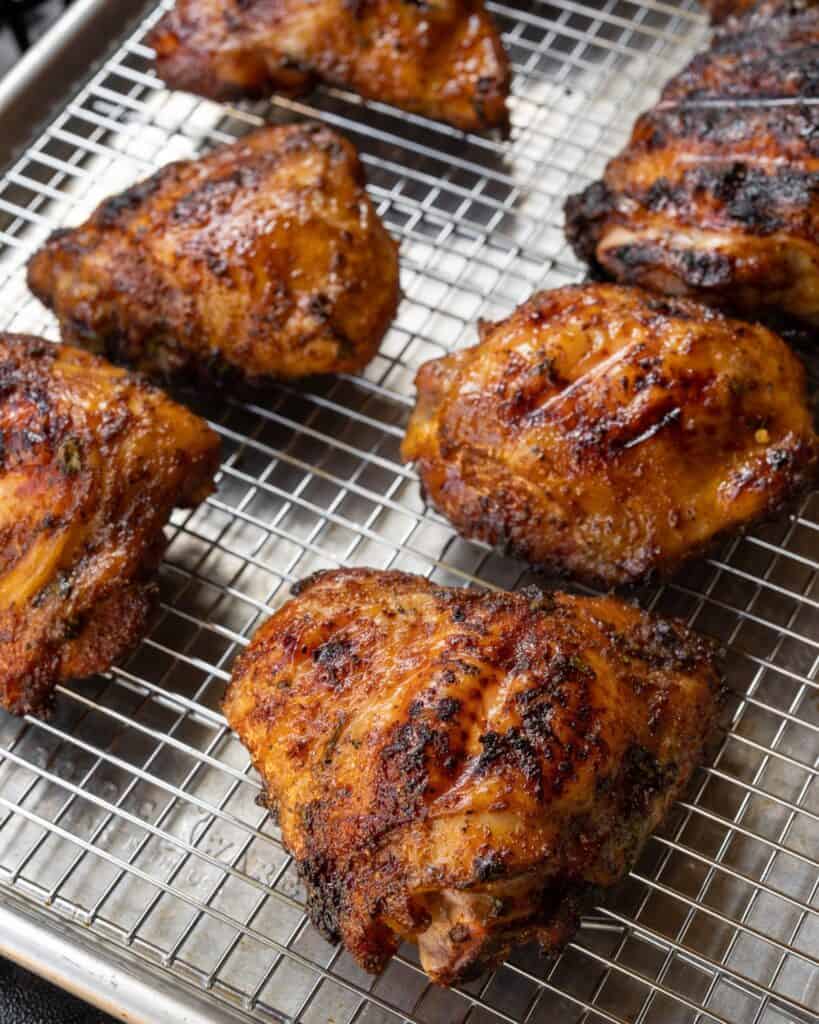
This recipe from Traeger seasons chicken thighs with a homemade ancho chile rub and cooks them at 375ºF before glazing with a homemade sauce made from tequila, pineapple, honey, and lime.
Where it’s unique is in its instruction to brush the sauce on the chicken skin, flip, brush the meat side, and finish cooking skin side down.
What I Learned: Cooking skin side down after glazing works (mostly).
Did I misread the recipe thanks to their confusing format and have to remake this recipe? You bet.
But on the second try I found cooking skin side down with the glaze really alleviated the textural issues I encountered with other glazed chicken thighs in this experiment.
While it wasn’t as crispy as the skin on the unglazed Chuds BBQ or the 0-400 chicken thighs below, it was the next best thing. Easy to bite through, bits of crisp where the sauce caramelized, and without any rubbery or overly chewy pieces.
I think this is definitely a worthy technique for those wanting to glaze their smoked chicken thighs while still having very tasty chicken skin.
A Few Tips for This Recipe
- Traeger calls for cooking the chicken thighs for 15 minutes before glazing. I cooked mine for closer to 45 to get the chicken to an internal temperature of 160ºF before glazing. Then I cooked for an additional 20-30 minutes to cook them beyond their recommended 165ºF internal temperature to 180ºF.
- The tequila honey and lime glaze is a bit slack, even if you double the cook time when reducing. You may want to add a bit more honey or butter to thicken it or let it cool a bit before brushing on the chicken.
- Keep an eye on the chicken thighs and possibly move them around to prevent some from burning once you’ve brushed on the glaze and are cooking skin side down.
Bradley Robinson (Chuds BBQ) Smoked Chicken Thighs
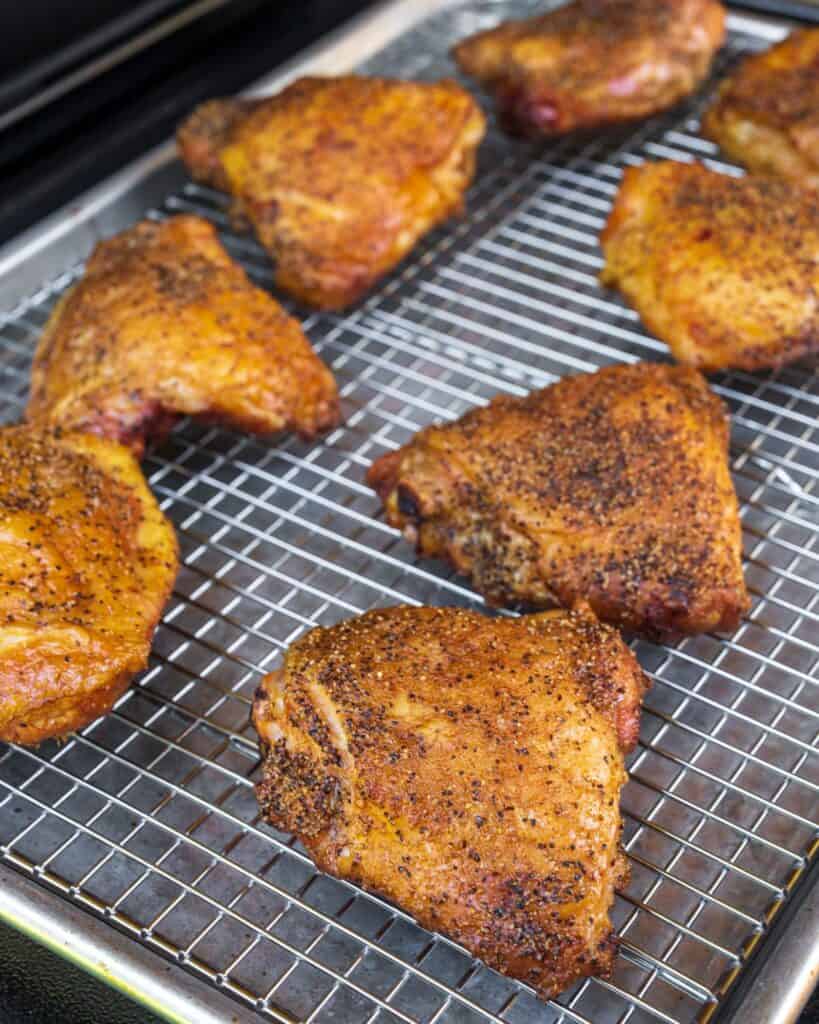
Bradley’s recipe is the only one of the bunch that recommends an overnight dry brine with salt. The chicken is then hit with a bit of black pepper, granulated garlic, and sprayed with duck fat before going on a smoker (he uses a Weber kettle).
He didn’t give a precise temperature in his video, but spying the temperature gauge on his grill yielded my best guess of 350ºF. Comparing the look of his chicken skin and crunch, I’d say he cooked a bit hotter (maybe closer to 400ºF) than I did.
Bradley cooked the chicken for about an hour before adding more duck fat. After another 30 minutes, he spritzed the chicken with a bit of hot sauce and cooked for an additional 10 minutes. The chicken was nearly 200ºF when it came off the grill.
Side note: I tried spritzing with hot sauce without any luck. None of my spray bottles could handle hot sauce or even watered down hot sauce.
What I Learned: Dry brining creates crispier skin and flavorful meat.
If you’re in a hurry, I wouldn’t say dry brining with salt (or even seasoning under the skin) is necessary. But it definitely helps dry out the skin and works its way into the meat. If you have guests that might be eating chicken without the skin, you’ll probably want to take the time to dry brine. It definitely doesn’t hurt!
The downside of cooking at a higher temperature, at least in my experience, is a reduction in smoke flavor compared to a recipe like Jeremy’s above. If you’re a crispy chicken lover, that’s probably worth the trade off. Even with Bradley’s higher temperature cook, the chicken was still on the grill for 90+ minutes. So it’s not like you’re picking up zero smoke.
Hey Grill Hey Smoked Chicken Thighs

Susie’s smoked chicken thighs meet somewhere in the middle of low and slow and higher temperature cooking. Her recipe recommends trimming excess skin, spraying with avocado oil, and seasoning on all sides, including under the skin.
The chicken is smoked at 275ºF for 45-75 minutes until it reaches an internal temperature of 165ºF before glazing with a sweet BBQ sauce and cooking a bit longer to take the chicken to at least 175ºF.
What I Learned: Crispy skin isn’t a must.
This recipe creates smoked chicken thighs with a soft (not rubbery) skin and plenty of flavor. While the softer skin isn’t necessarily my jam, I think some people will prefer it over the unglazed crispy chicken. The sauce picks up a bit more smoky flavor in addition to its own sweet flavors. That’s a great eating experience, especially if you have the right sides.
Susie does mention in her recipe video that you could increase the grill temperature to 400ºF to create a crispier skin and caramelize the skin. I didn’t test this, but I’ve included some thoughts about crisping glazed skin in the final takeaways below.
Hey Grill Hey 0-400 Smoked Chicken Thighs
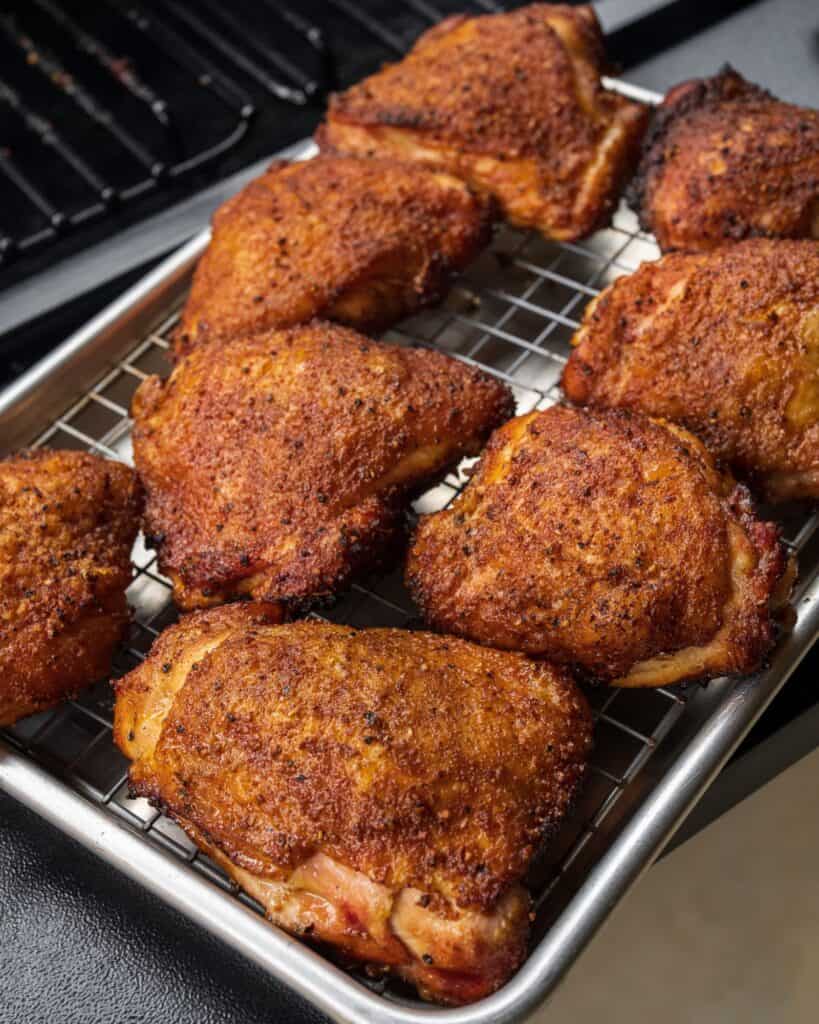
The name may sound gimmicky, but this was my favorite recipe on the list and quite possibly the best chicken I’ve ever cooked. As for the method, it’s all in the name. Seasoned bone-in chicken thighs sprayed with avocado oil go on a cold smoker and stay on the grill for about an hour as it goes from zero to four hundred degrees.
Susie from Hey Grill Hey mentioned in her video this method has been floating around the Recteq forums for a while and that members said dirty smoke wasn’t an issue.
I was skeptical but definitely found that to be the case as well, at least on a pellet grill. The chicken reaches an internal temperature of 185ºF in about an hour. The skin is crispy, the meat is juicy, and the extra crispy bits around the edges somehow have a flavor resembling crispy smoked bacon.
What I Learned: This will be my go-to method for making smoked chicken thighs.
This recipe produced my favorite chicken of the bunch, and it was also in contention for the easiest.
I trimmed excess skin with kitchen sears and seasoned with Traeger’s chicken rub. And that’s it. The chicken went on the Traeger, I set the grill to 400ºF, and I came back to perfectly smoked chicken thighs an hour later.
Update: I used this method with peppers and onions alongside the chicken thighs to make some killer smoked chicken tacos.

My Key Takeaways for Making the Best Smoked Chicken Thighs
While I think you could take the 0-400 chicken recipe and just run with it, I learned a handful of things during this experiment that I think you’ll find helpful. Just store these in the memory bank for future cooks.
Pick One: Glazed with Sauce or Crispy Chicken Skin
I found glazing smoked chicken thighs creates soft (best case) and sometimes rubbery skin. While the finishing skin side down method from Traeger’s tequila lime chicken made the best chicken skin of the glazed group, I’d recommend fans of crispy chicken skin serve sauce on the side.
I’ve seen people in forums mention placing their glazed chicken under their oven’s broiler for 5-10 minutes to crisp the skin, but I could see where this could also enhance the rubberiness in some cases.
Use Extra Fat for Crispy Skin
In my testing, the recipes that called for spraying on fat (Bradley’s duck fat and Susie’s avocado oil) both after applying the rub and during the cook produced the crispiest skin. This may sound like a duh statement, but it made an even bigger difference than expected.
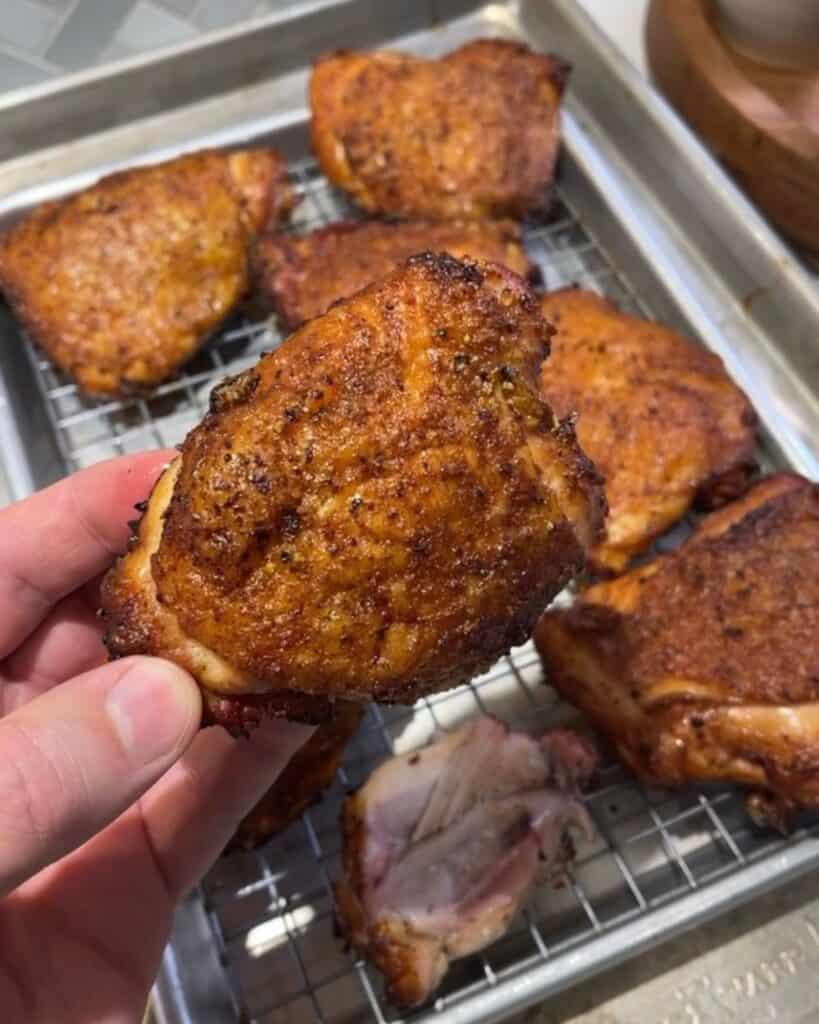
Skip the Brine?
Dry brining with salt definitely helps the chicken skin dry out, but it’s more than possible to create really crispy skin without it. You can also pack a ton of flavor into your smoked chicken thighs during the cook and with a simple rub. And I didn’t run into dry chicken with any of these cooks. That’s a perk of using fattier chicken thighs over something like chicken breast.
That said, if you have the time, it certainly doesn’t hurt to let the chicken get to know a little salt in the refrigerator.
I didn’t test any recipes that called for a submerged brine, but I’m assuming both produce similar results.
Cook to AT LEAST 175ºF
Most recipes I included call for cooking the chicken to an internal temperature somewhere between 175ºF to 185ºF, which is on the money. This temperature ensures all the fat renders and connective tissue breaks down.
I cooked all the chicken thighs closer to an internal temperature of 185ºF without any dry white meat. Take a look at Bradley’s smoked chicken thighs, for an example of what chicken thighs cooked to nearly 200ºF look like. Spoiler: still plenty juicy.
To Trim or Not to Trim
I found trimming excess skin around the edges, fully exposing the bottom “meat side” produced the best eating experience. The stray pieces and thin pieces of fat tend to burn anyway.
Kitchen shears make easy work of this, and it gives you a good excuse to pat the chicken dry with a paper towel before adding any rub. I think that’s always a good idea.
Rub Ingredients
If you’re a DIY seasoning type of person, tread carefully with finely ground spices. Jeremy mentioned in his recipe that finely ground rub ingredients can inhibit the chicken from picking up smoke flavor. I also found an onion powder and ground ginger heavy rub created a gritty texture on the skin.
If you’re using finely ground ingredients, be sure to coat the chicken in oil while applying like in the Traeger chicken thighs recipe.
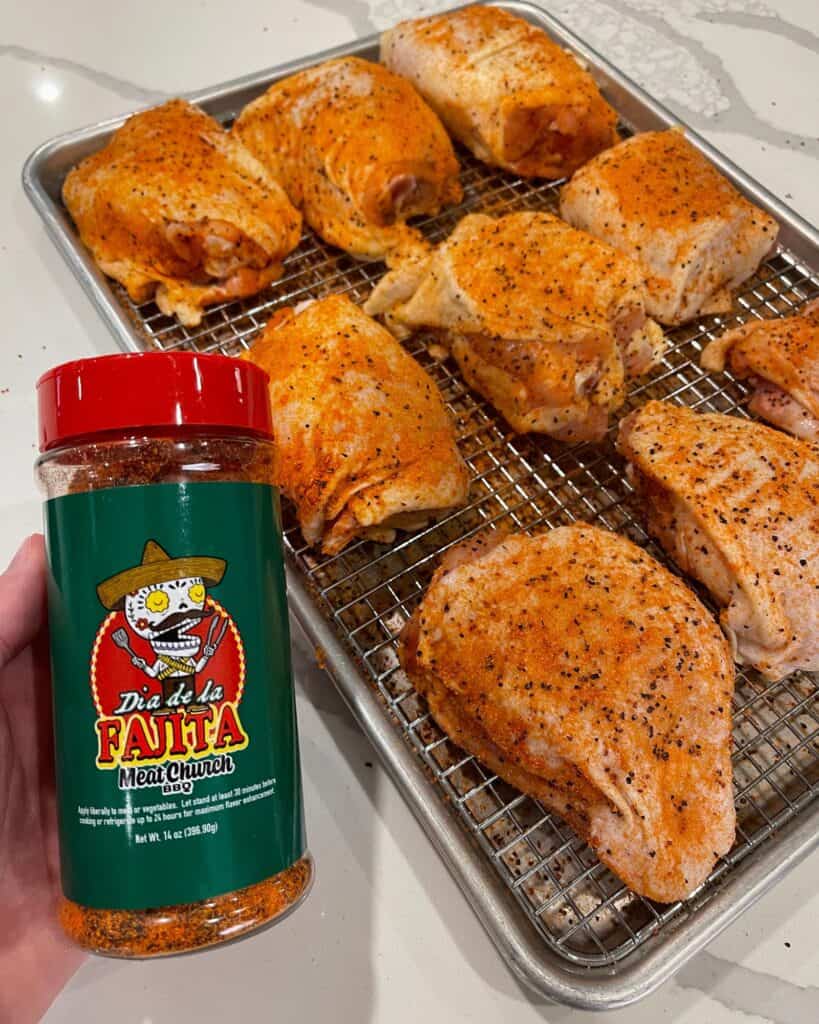
And don’t sleep on all the available rubs out there. Some have ingredients you won’t have in the spice cabinet that can work some meat magic.
TL;DR and Final Thoughts
Okay, if you’re making smoked chicken thighs, I’d recommend trying the 0-400 method. Trim the excess skin and fat from bone-in, skin-on chicken thighs, season with your favorite rub (I had amazing results with Traeger’s chicken rub), and place directly on the grill grates of a cold smoker. Fire up the grill to 400ºF and set a timer for an hour. Once the chicken reaches 185ºF internally, pull and rest before serving (sauce on the side).
This method works especially well for pellet smokers. If you’re worried about dirty smoke or want to glaze, I’d go with the low and slow method from Jeremy Yoder.
And that’s that. I hope this post was helpful and you picked up a thing or two for making awesome smoked chicken thighs. If you’d be interested in more cook offs on the smoker, I’d love some ideas on potential dishes and recipes. Feel free to leave them in the comments below.
Our next project is finding the best smoked mac and cheese recipe out there. So be sure to subscribe to our newsletter to find out when that’s published.
And if you’re looking for more chicken recipes to make on a Traeger or pellet smoker, check out my smoked chicken salad, BBQ chicken meatballs, or Traeger grilled chicken breast before you hit the road. Or if you need something to do with all the leftover smoked chicken thighs you’ll have shortly, check out my smoked chicken cheese dip or leftover BBQ chicken quesadillas.

